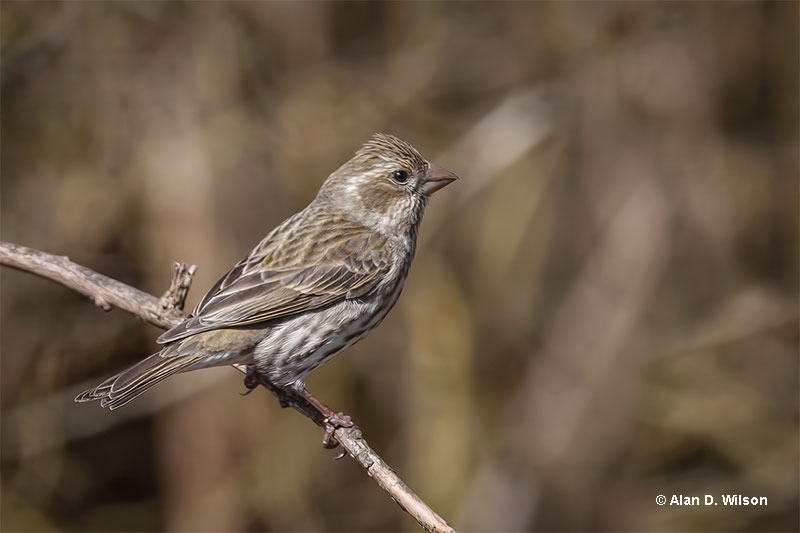
Bird names can be obviously descriptive or as intriguing and mysterious as the birds themselves. Some carry historical or geographical significance, while others reflect unique traits or behaviors.
Ever wondered about the stories behind some bird names? Well, here is your chance to find out more about the names of North American birds from the Pacific Golden-plover to Pyrrhuloxia!
On this page
- Birds That Start With P
- Pacific Golden-Plover
- Pacific Loon
- Pacific-slope Flycatcher
- Painted Bunting
- Painted Redstart
- Palm Warbler
- Pectoral Sandpiper
- Pelagic Cormorant
- Peregrine Falcon
- Phainopepla
- Philadelphia Vireo
- Pied-billed Grebe
- Pigeon Guillemot
- Pileated Woodpecker
- Pine Grosbeak
- Pine Siskin
- Pine Warbler
- Pinyon Jay
- Piping Plover
- Plain Chachalaca
- Plumbeous Vireo
- Prairie Falcon
- Prairie Warbler
- Prothonotary Warbler
- Purple Finch
- Purple Gallinule
- Purple Martin
- Purple Sandpiper
- Pygmy Nuthatch
- Pyrrhuloxia
- Bird families starting with P
Birds That Start With P
Pacific Golden-Plover
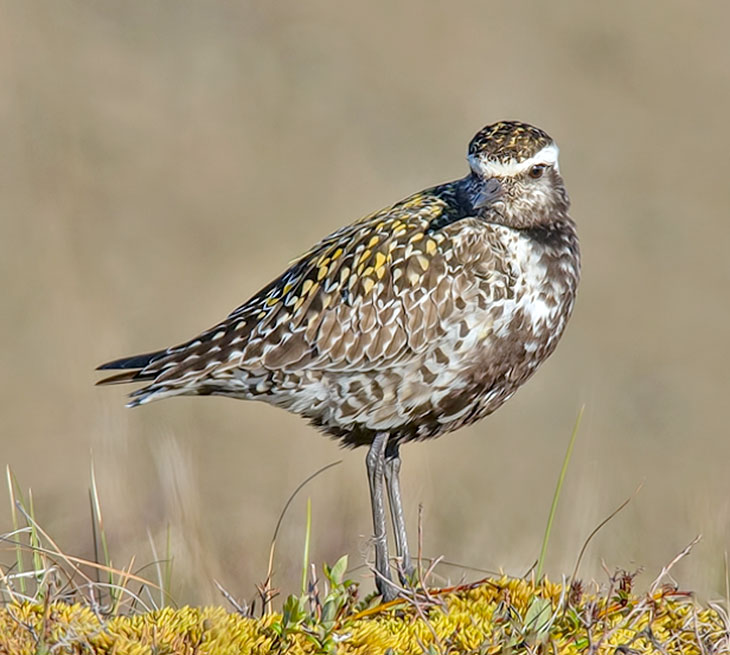
The Pacific Golden-Plover is a migratory shorebird belonging to the plover family. It derives its name from both its striking appearance and range.
Throughout its life stages—from juveniles and immatures to non-breeding and breeding adults—individuals are adorned with mottled golden plumage. The inclusion of “Pacific” in its name reflects its predominant range and habitat.
They are commonly observed along the coasts bordering the Pacific Ocean, spanning from parts of Asia and Australasia to the Americas.
Pacific Loon
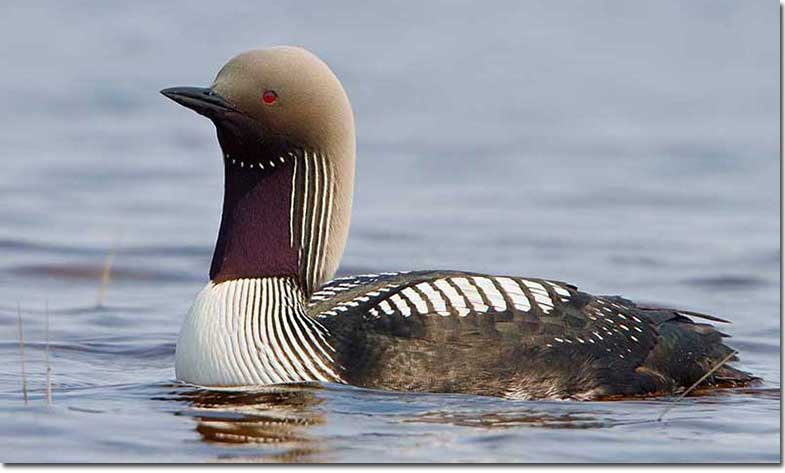
The Pacific Loon is a medium-sized member of the aquatic diving bird family known as loons. It earned its name from its association with the Pacific Ocean since the species breeds and winters along and near its coasts. They are excellent swimmers and dive underwater to catch fish. This earned them the nickname Pacific diver.
Pacific Loons are nearly identical to Black-throated Loons and were once considered the same species. The distinction between them was recognized by scientists in 1985 based on morphological differences. This evolutionary split is estimated to have occurred around 6.5 million years ago.
Pacific-slope Flycatcher
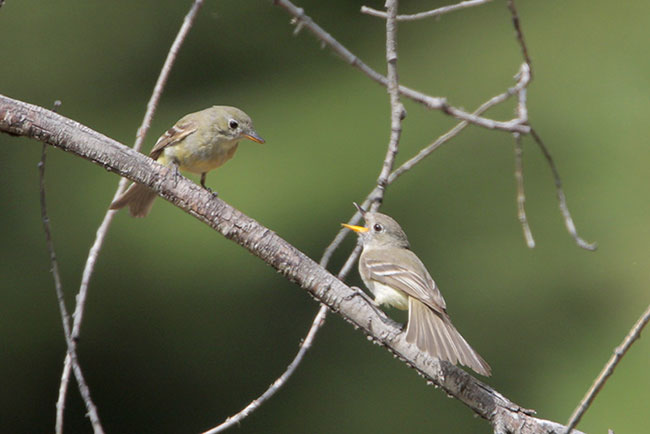
The Pacific-slope Flycatcher is native to forests and mountain ranges along the Pacific Coast and Rocky Mountains. This small bird is a joy to behold during its hunts. It darts out from perches to snatch insects in mid-air or hovers to glean them from foliage.
Related: Are bird range maps always accurate?
Until 1989, it was classified as the Western Flycatcher alongside the Cordilleran Flycatcher because they both looked virtually identical. The split was based on habitat preferences and subtle differences in vocalizations.
However, recent studies into vocalizations, genetics, and morphology led the American Ornithologists’ Union and International Ornithological Congress to lump the two species back into one in the year 2023. It turns out that the differences in those areas were inconsistent and the two species hybridized extensively.
Painted Bunting
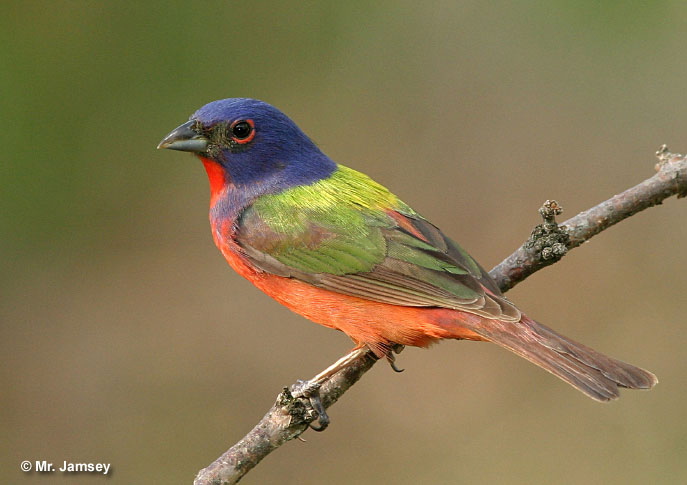
The Painted Bunting earns its name from the stunning appearance of the male bird, whose plumage resembles a picture of a bird colored by a child. Males have brilliant blue heads, green upper backs, red bellies, and red rumps. Females are more uniform in coloration, but still a beautiful yellowish-green.
This songbird is also known by various other names, including the Mexican Canary, reflecting its wintering grounds in Mexico; the Painted Finch, highlighting its finch-like body shape and bill; and the Nonpareil, a French term meaning “without equal,” acknowledging its beauty among birds.
Painted Redstart
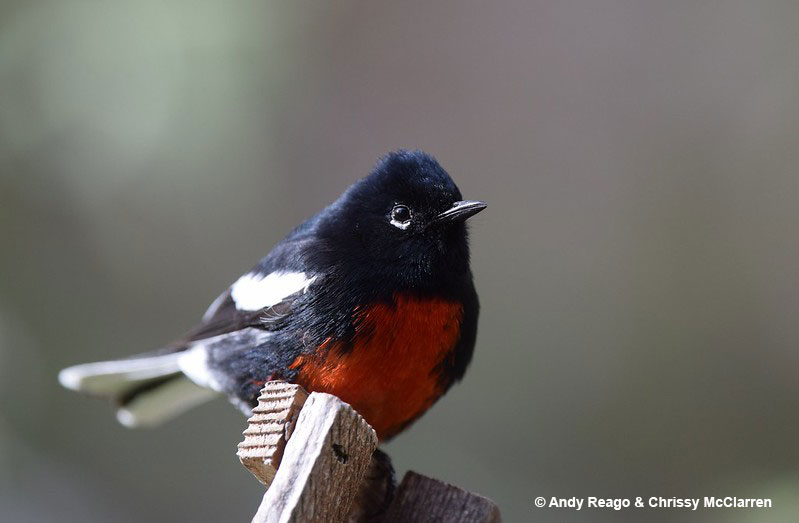
The Painted Redstart earned its name due to its striking appearance and flamboyant behavior. They constantly flash their black-and-white wings and fan their tails adorned with white outer feathers while foraging.
Initially classified in the genus Setophaga alongside the American Redstart in 1829, the term “start” in its name comes from the old English word steort, meaning tail.
By the mid-1960s, researchers reassigned the Painted Redstart to the genus Myioborus which contains whitestarts. This is why this species is also called the Painted Whitestart. This name highlights the distinctive white tail feathers characteristic of this group of birds.
Palm Warbler
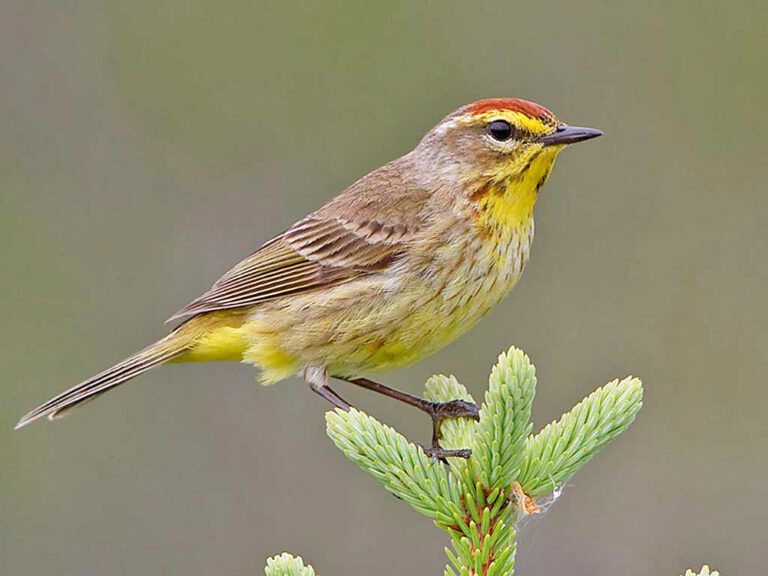
The name Palm Warbler might suggest a tropical bird that nests in palm trees, but it is actually one of the northernmost breeding warblers. Their name is based on an individual collected from a Caribbean island abundant with palm trees.
Palm Warblers have two subspecies: the Yellow Palm Warbler (or Eastern Palm Warbler) and the Brown Palm Warbler (or Western Palm Warbler).
The former inhabits the eastern third of their range and has brownish-olive upperparts and yellow underparts. On the other hand, the latter is found in the western two-thirds of their range and has less yellow, muted streaking, and cold grayish-brown upperparts.
Pectoral Sandpiper
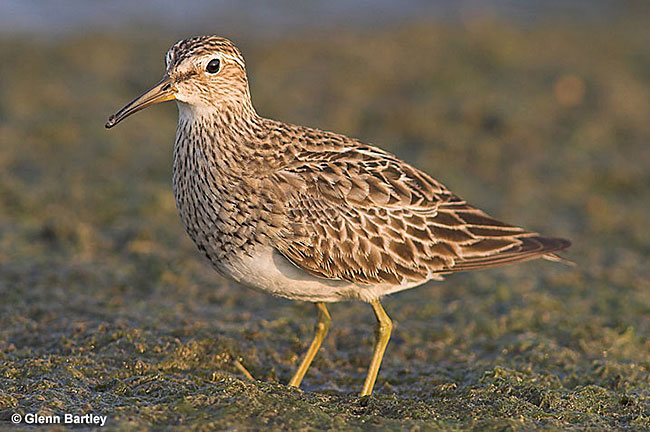
Pectoral Sandpipers are relatively small wading birds belonging to a genus of Arctic-breeding shorebirds called Calidris. In spring, males establish territories by putting on vigorous flight displays and emitting odd mooing calls. Ground displays are equally captivating. Males cock their tails, droop their wings, inflate their breasts, and emit high-pitched calls while marching, swaying, and stretching their necks.
‘Pectoral’ refers to the inflatable air sacs males use to produce those hooting calls.
Pelagic Cormorant
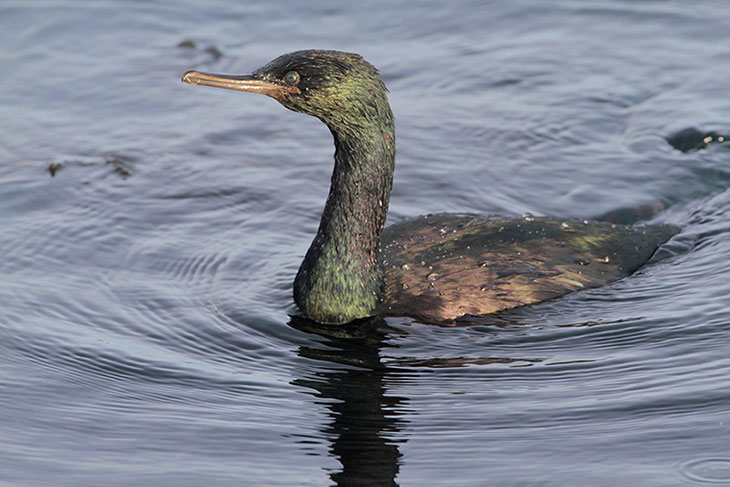
The word ‘pelagic’ derives from the Ancient Greek word pélagos, meaning ‘open sea’ or ‘of the open ocean’, although it is somewhat misleading for this species.
Despite the name, Pelagic Cormorants are typically found relatively close to the shore, rarely venturing more than a few miles from the lands. They are adept divers and underwater hunters, capable of holding their breath for up to 2 minutes and diving as deep as 138 feet.
Pelagic Cormorants are also known as the Baird’s Cormorant, likely honoring American naturalist Spencer Fullerton Baird, or the Violet-green Cormorant due to the metallic green and violet iridescence seen in adults. They are occasionally also referred to as Pelagic Shags.
Peregrine Falcon
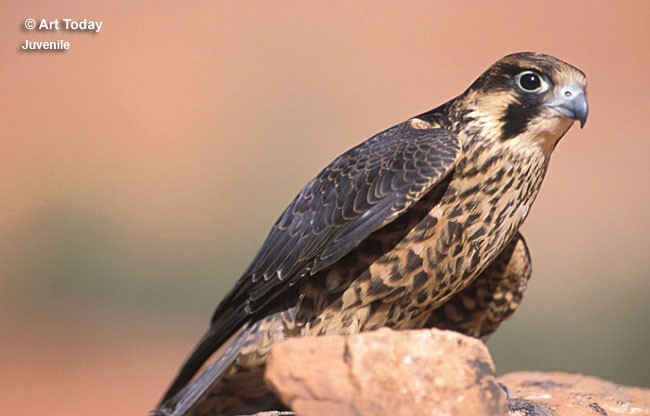
The Peregrine Falcon is a renowned bird of prey recognized as the fastest member of the animal kingdom thanks to its high-speed hunting dives that can reach speeds of over 200 mph. Both its English and scientific name reflect the raptor’s extensive range, migratory behavior, and body shape.
Peregrinus comes from Latin and means ‘to wander’ while falco is related to falx and means ‘sickle’. The former refers to the fact that these falcons range across every continent except for Antarctica and cover thousands of miles during migration while the latter reflects the bird’s silhouette while in flight.
In North America, they are also known as the duck hawk or pigeon hawk due to their favored prey: ducks and pigeons.
Phainopepla
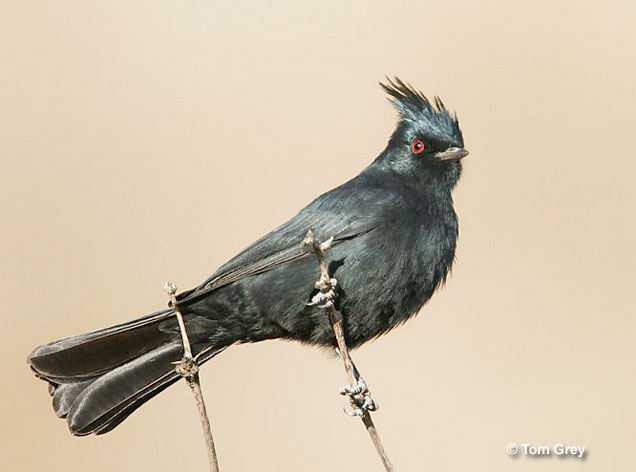
The name Phainopepla has its roots in Ancient Greek and can roughly be translated as ‘shiny cape’. Phaino means ‘to shine’ or to appear bright’ while peplos refers to a cape- or cloak-like garment.
This name aptly describes the striking appearance of males of the species, who feature glossy black plumage and a noticeable crest. The “shining cape” effect of their plumage is particularly noticeable in sunlight. These birds are a stunning sight in their arid and desert habitats across the southwestern United States and Mexico.
They are also known as the Northern Phainopeplas because their range extends the farthest north compared to others in their family.
Philadelphia Vireo
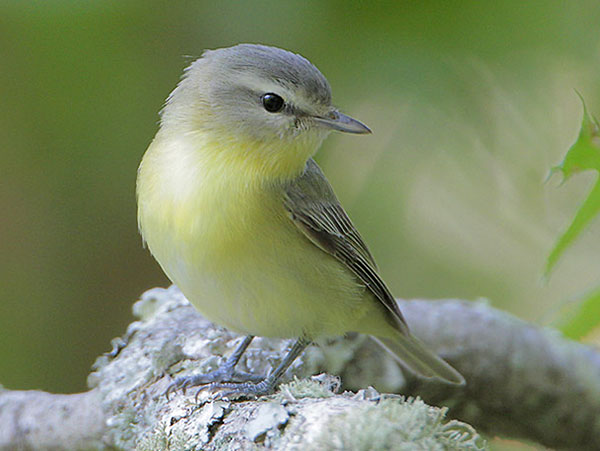
The Philadelphia Vireo is a member of the genus Vireo, which contains small passerines with typically dull greenish plumage. The name for this genus comes from the Latin virere, meaning ‘to be green’. This vireo species is no exception – they have pale yellowish bellies, gray crowns, and grayish-olive backs.
‘Philadelphia’ refers to the city in the northeastern United States. John Cassin, an American ornithologist, named the species in 1851 based on a migrating individual he saw in this city. Despite its name, these vireos do not nest there and are only uncommon migrants. Before that, they were known as Brotherly-love Vireos.
Pied-billed Grebe
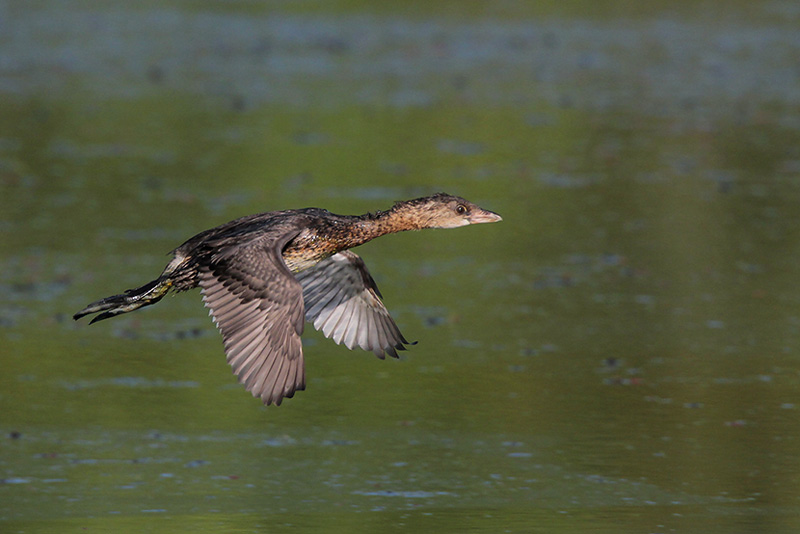
The Pied-billed Grebe is named for its distinctive two-colored bill. ‘Grebe’ possibly comes from the Breton word krib, meaning ‘comb’, a reference to their crests.
This bird goes by numerous other names, including dabchick, pied-bill, Carolina grebe, devil-diver, hell-diver, dive-dapper, dipper, and water witch. The name ‘dabchick’ can be decrypted as ‘a chick-like bird that dives’ with the first part of the name originating from Middle English doppen meaning ‘to dive’.
Hell-diver and water witch are names inspired by the speed at which they can submerge. This species spends nearly all their time on the water and if threatened, quickly leaps head-first into the water and emerges with only its head visible.
Pigeon Guillemot
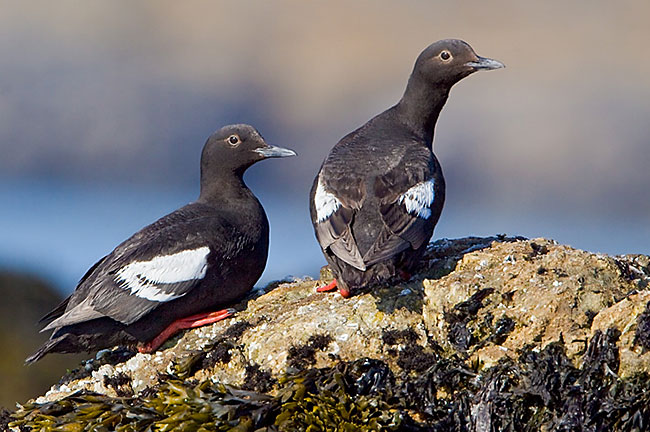
Pigeon Guillemots are medium-sized seabirds in the true guillemot genus Cepphus. They have an upright posture, walk well on land, and are rather short and round with a small head, resembling a pigeon in shape. The other part of their name is derived from Old French Guillaume, which in English simply means ‘William’.
Pileated Woodpecker
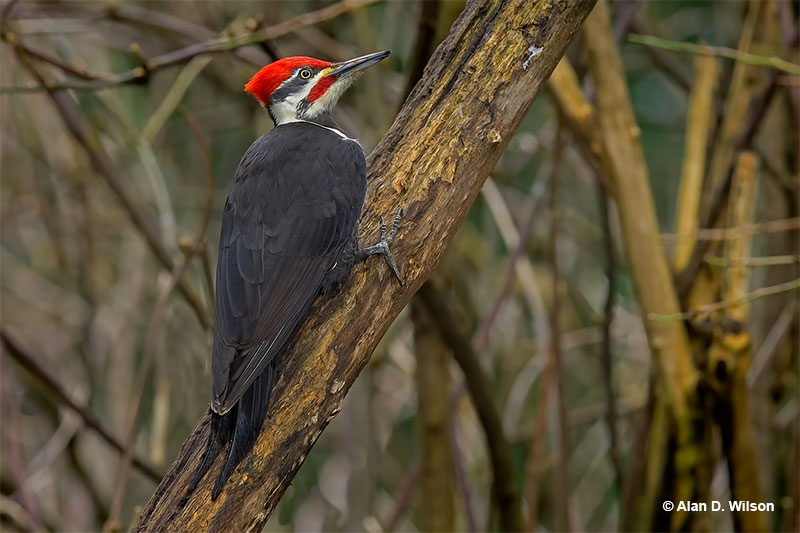
The Pileated Woodpecker is a large woodpecker native to the deciduous and boreal forests of North America. They get their name from their appearance and foraging habits. In Latin, pileatus means ‘capped’, referring to the bird’s distinct red crest.
Like many other woodpeckers, this species is also known for drumming and chipping holes in trees to uncover insects and excavate nesting holes. Their excavation can be so impactful that the resulting holes may end up with the tree splitting in half.
Pine Grosbeak
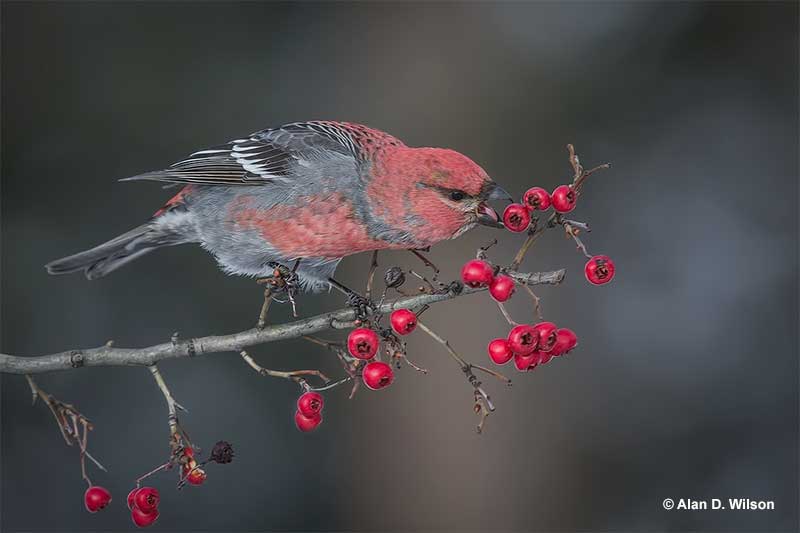
The Pine Grosbeak, a large member of the true finch family, is commonly found in coniferous forests across northern North America. With their thick and conical bills, they easily crush seeds and nibble on tree buds and needles.
These birds prefer breeding in open spruce, fir, and pine forests, showing a strong preference for pine trees. The term “grosbeak” is shared among various species of seed-eating birds within the Passeroidea superfamily, derived from the French grosbec, where gros means “large” and bec means “beak”, highlighting their characteristic large bills.
Pine Siskin
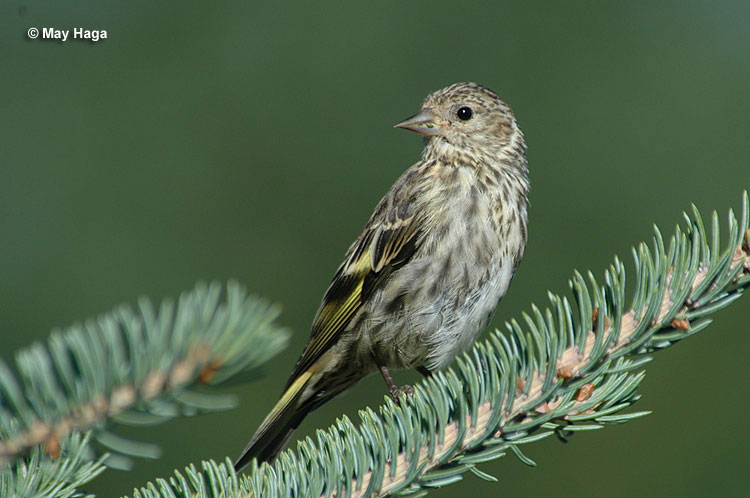
The Pine Siskin is named for its preference for coniferous woods, especially those with pine trees, where it forages for seeds. You may even see them hanging upside down from the tips of branches. They also catch insects and visit bird feeders for smaller seeds.
Siskin refers to a group of small finches characterized by their thin, pointed bills and cheerful, twittering calls. The word “siskin” is believed to originate from the German dialectal term Sisschen, which means “small bird” or “chirper.” This name aptly describes their petite size and lively tunes.
Pine Warbler
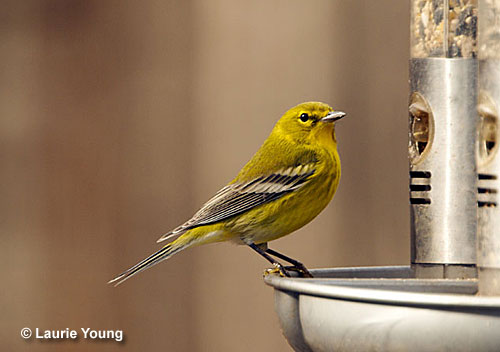
Pine Warblers are primarily found in pine or mixed pine-deciduous forests across the western United States. Unless they are migrating, they are rarely seen on deciduous trees or even other coniferous trees.
They move relatively slowly along branches, gleaning insects and other small invertebrates from bark and needles. During winter when prey is lacking, they also munch on fruits and seeds, preferably on pine seeds. Males sing fast warbling trills with virtually no variation in pitch.
Pinyon Jay
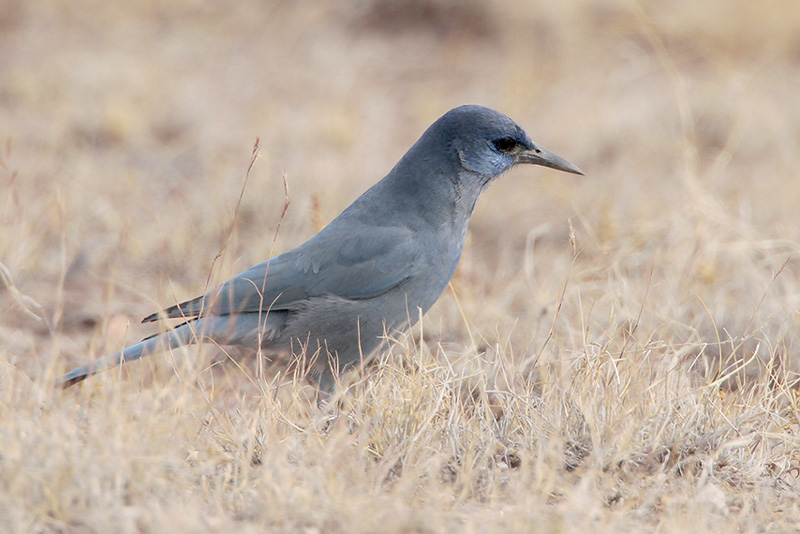
Pinyon Jays are named after their strong association with pinyon pine trees. They heavily rely on them for nesting and roosting and their seeds for food. On the other hand, the birds help the trees by dispersing their seeds.
There is some debate over who first saw, described, and recorded the species. Some claim that the first encounter was in 1833 by the Prince Maximilian of Wied-Neuwied expedition, whereas others say that it was first described by the Lewis and Clark Expedition in 1805.
Before getting their official name from the International Ornithologists’ Union, they were also known as the blue crow or Maximilan’s Jay. The former refers to the bird’s blue-gray plumage and crow-like shape.
Piping Plover
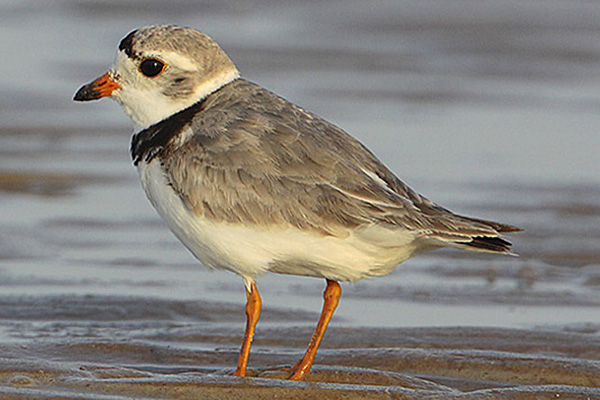
Photograph © Greg Lavaty.
Piping Plovers are small sparrow-sized shorebirds. They are mostly sand-colored above and white below, helping them blend into their habitat rather seamlessly. You are more likely to hear their clear piping call before seeing them, hence the name. Like other plovers, they have compact bodies and often run along coasts and shorelines in search of food.
Plain Chachalaca
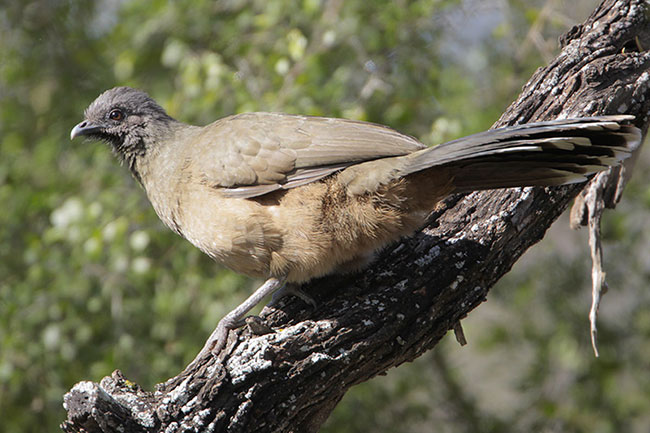
Photograph © Greg Lavaty
The Plain Chachalaca is a large chicken-like bird with a brown overall appearance and a long tail. Its name Chachalaca comes from the Spanish word for ‘to chatter’, reflecting its noisy nature. Paired birds loudly sing in the early morning and evening and when the weather is about to change with their hoarse and raucous cha-cha-lac calls.
See more: Funny bird names & innuendos
They are also known as Mexican Tree Pheasants, as they spend significant time in trees despite being part of the mostly ground-dwelling family Galliformes. Found mainly in Mexico with a small population in southern Texas, they prefer dry and moist forests interspersed with scrub and savanna.
Plumbeous Vireo
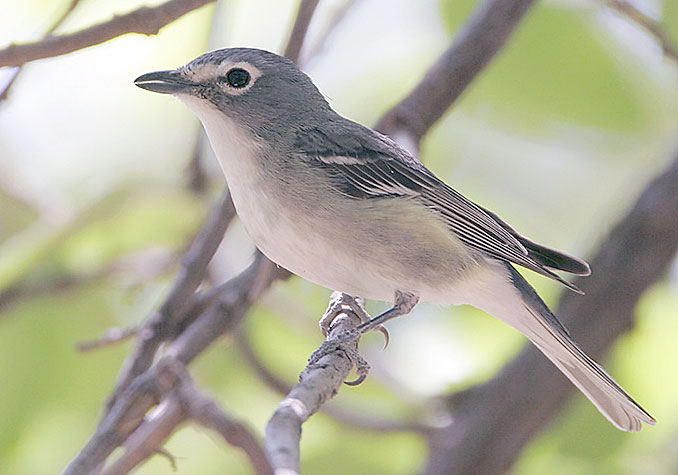
Photograph © Greg Lavaty
The Plumbeous Vireo earns its name from its striking gray plumage, particularly its rich gray upperparts. “Plumbeous” originates from the Latin word plumbeus, meaning ‘leaden’, which is derived from plumbum, the Latin term for lead—a soft, silvery-gray metal.
Interestingly, Plumbeous Vireos were previously known as Solitary Vireos until 1997, along with two other vireo species—the Cassin’s Vireo and Blue-headed Vireo. This former name likely reflects their solitary nature during migration.
Prairie Falcon
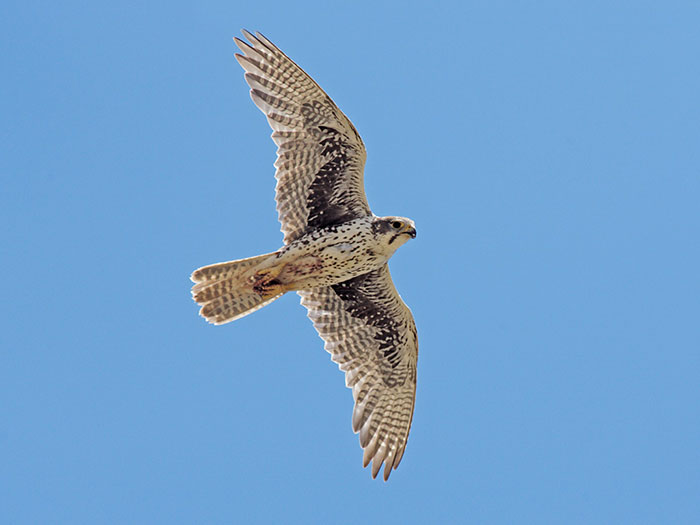
The Prairie Falcon is a raptor known for its affinity for wide-open spaces in the western regions of the United States, including shrubby deserts, grasslands, steppes, deserts, and plains.
Their dull brown uppersides and pale dark-streaked undersides help them camouflage against the earthy tones of the landscapes they inhabit. But they don’t rely on appearance alone.
When hunting, they fly low over the ground to take their prey by surprise. Some of them are also quite playful! They have been observed to drop an object in mid-air and then swoop down to catch it.
Prairie Warbler
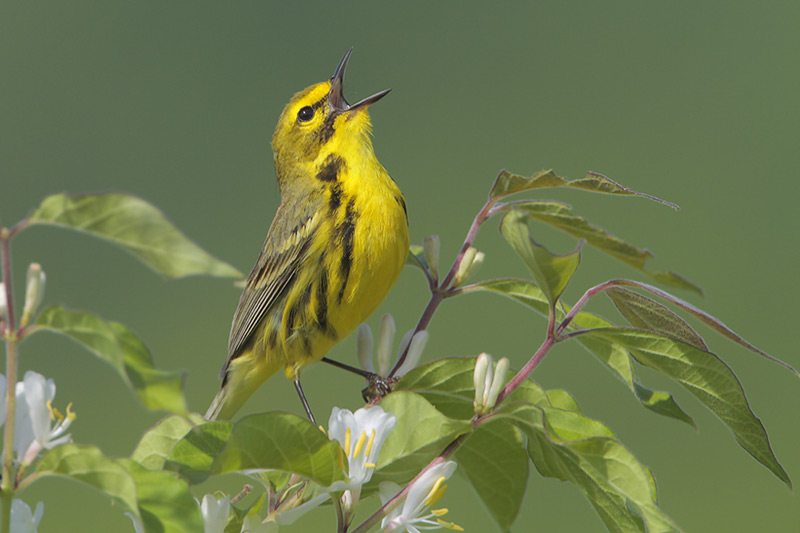
Prairie Warblers are beautiful yellow-olive birds with black markings.
However, the name is somewhat misleading, as these warblers are not exclusive to open grasslands. In reality, they are more commonly found in scrubby habitats with scattered trees and shrubs, in open woods, forest edges, and mangroves.
You can locate them by the distinctive buzzy zee-zee-zee-zee-zeeee song that accelerates and rises in pitch.
Prothonotary Warbler
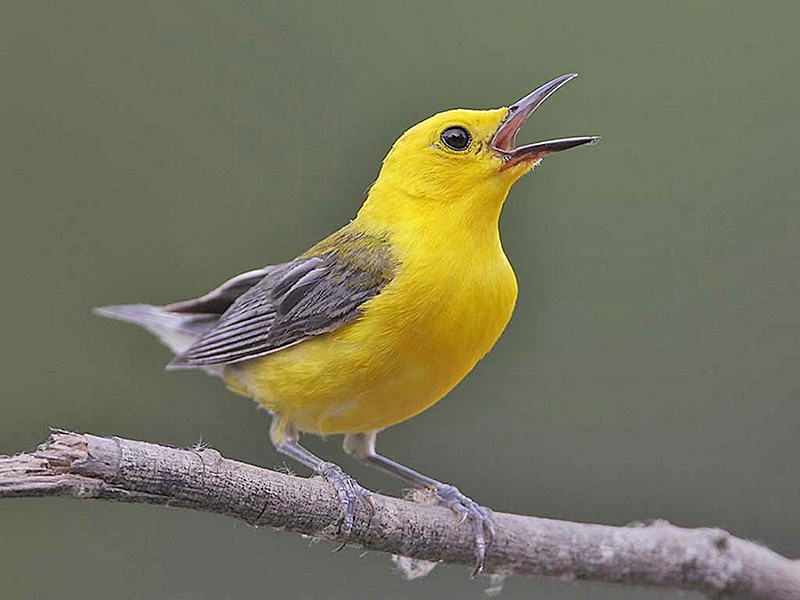
Photograph © Greg Lavaty.
Prothonotary Warblers derive their name from their plumage reminiscent of the yellow robes once worn by prothonotaries. They are striking birds with bright golden-yellow coloration, complemented by blue-gray wings, rump, and tail, as well as a yellow-olive back.
This vivid coloration serves a practical purpose. Brighter yellow males are more likely to secure better nesting sites than their less colorful counterparts. Due to their affinity for wetlands, the Prothonotary Warbler is also known as the swamp warbler. They predominantly inhabit hardwood swamps across extreme southeastern Ontario and the eastern United States.
Purple Finch
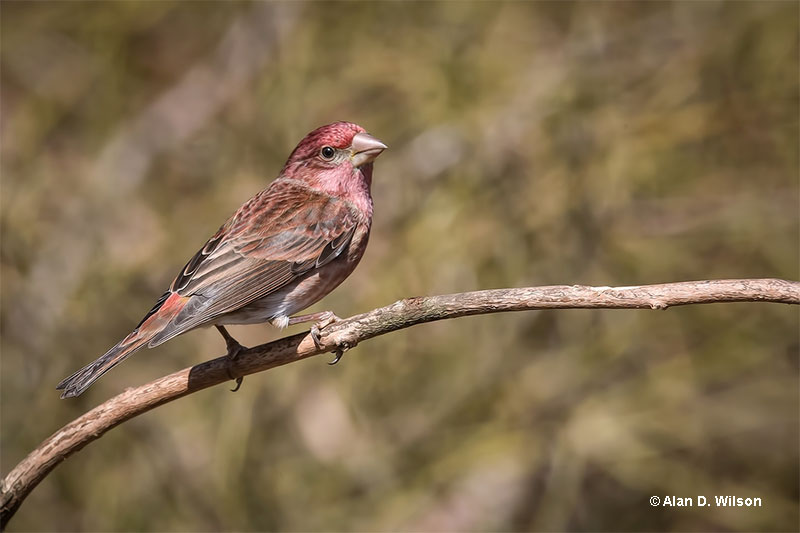
The Purple Finch is famously described as a ‘sparrow dipped in raspberry juice.’ They are named for the reddish-purple hue of the male bird’s plumage, particularly noticeable on its head, throat, and chest.
Males’ overall coloration can vary from a deep raspberry-red to a more subdued pinkish-red, depending on factors like age, diet, location, and genetics.
The name Purple Finch has persisted over time, even though the coloration is more accurately described as shades of red. The female Purple Finch, on the other hand, has a more subdued appearance with brown streaks and a distinctive white eyebrow.
Purple Gallinule
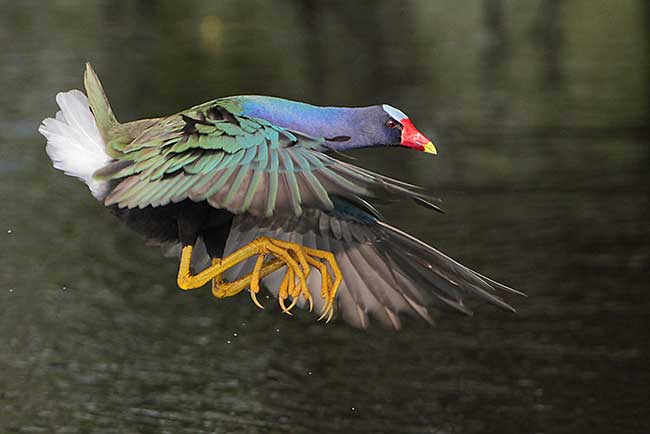
The Purple Gallinule is named for its appearance. Their plumage includes shades of purple, blue, purple, and green on its body. The term “gallinule” refers to its classification as a member of the rail family, which includes marsh-dwelling birds with chicken-like appearances.
Gallinule comes from Old French gallinule which in turn originates from Latin gallinula, meaning chicken or hen. The Purple Gallinule is often found in freshwater marshes, which is why they are also known as swamp hens, and their yellow feet lend them the nickname Yellow-legged Gallinule.
Purple Martin
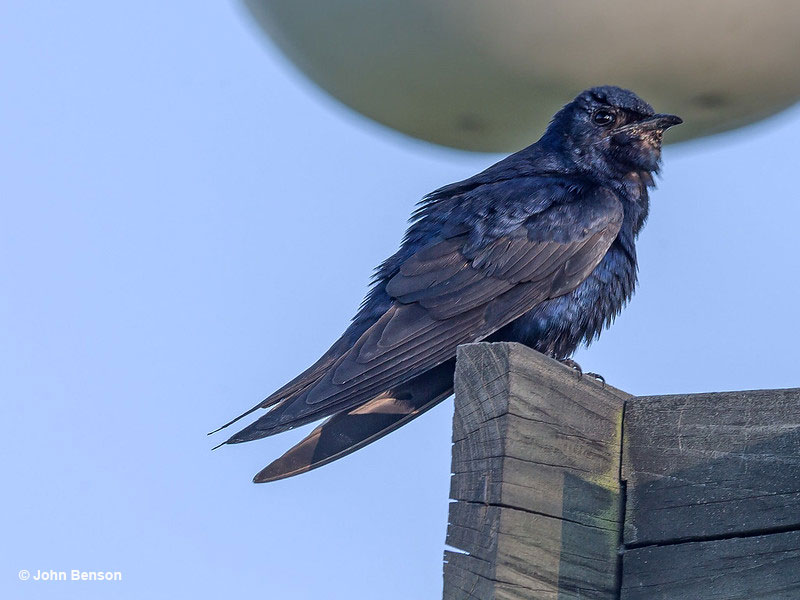
The Purple Martin, North America’s largest swallow, is named for its iridescent dark plumage that mostly appears to have an iridescent blue sheen.
It may also have a deep purple or green gloss, depending on the light. In 1750, English naturalist George Edwards called it the Great American Martin in his book. Other names like Gourd Martin or House Martin highlight its preference to nest in hollow gourds or under the eaves of houses whereas the nickname Black Martin emphasizes its black plumage.
For some reason, it is also called the Western Martin, although it mostly breeds in eastern North America.
Purple Sandpiper
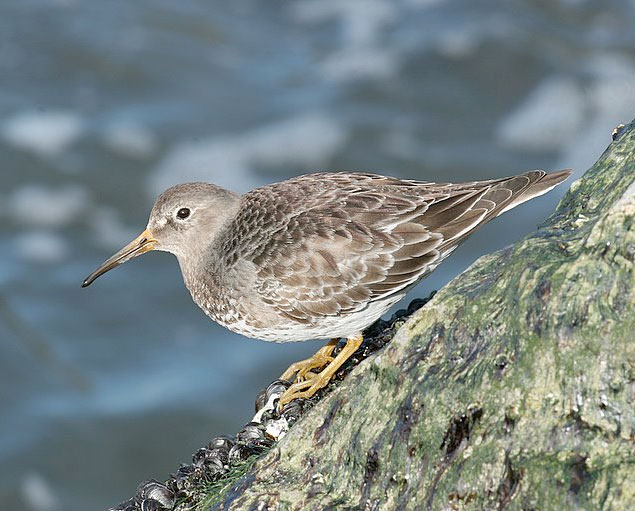
Purple Sandpipers are plump shorebirds with mostly gray uppersides, some reddish brown on the shoulders, and pale undersides with dark speckling.
Non-breeding adults are grayish overall with a pale underside and a purplish sheen on parts of the wing feathers, hence the name. However, that sheen is rather difficult to see.
The birds belong to the sandpiper family, characterized by their foraging habits and vocalizations. They use their long bills to probe the sand or mud for small invertebrates and call with high-pitched peeping sounds.
Pygmy Nuthatch
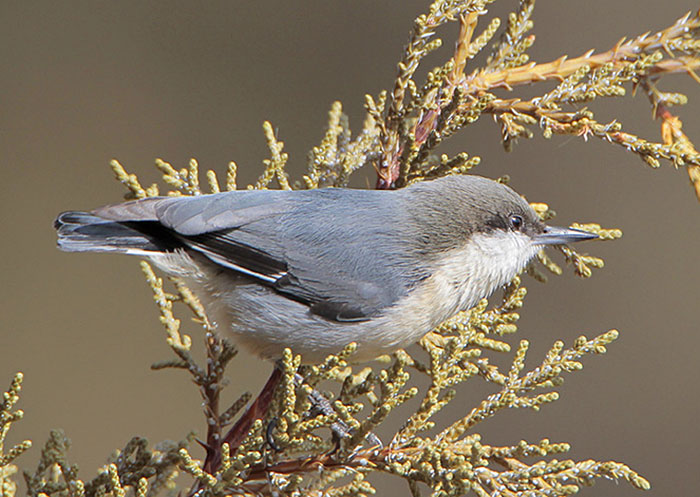
Photograph © Greg Lavaty
The Pygmy Nuthatch derives its name from the Latin pygmaei, which originates from the Ancient Greek pugme, meaning ‘as small as a fist’. In English, ‘pygmy’ describes something very small of its kind.
True to its name, Pygmy Nuthatches are small compared to others of the Nuthatch genus, measuring only 3.5-4.3 inches long.
These energetic birds climb up and down tree trunks, hunting insects and foraging for seeds. They often wedge tougher nuts and seeds into tree bark and then whack them with their sharp bill until they get to the tasty core. This kind of ‘nut hatching’ is the source for the second part of their name.
Pyrrhuloxia
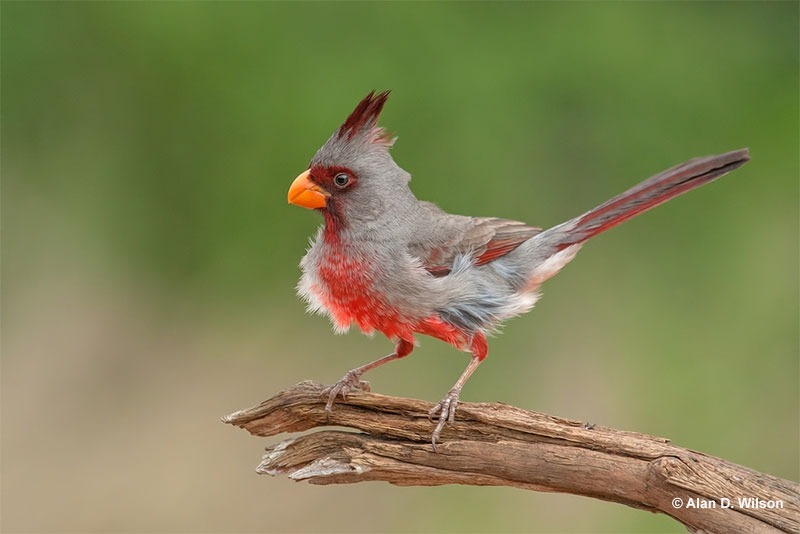
If you can’t decipher what Pyrrhuloxia should look like based on its name, then that’s just because you don’t know Greek.
These birds are mostly gray to grayish brown with red on their wings, crest, face, breast, and tail. They have short but heavy bills with a curved upper edge. Hence the name! Phyrros stands for reddish or orange and loxos for oblique, referring to the shape of its bill.
These cardinal-like birds inhabit mesquite thickets and desert scrub in Mexico and the southernmost United States. This is why they are also known as desert cardinals.
Bird families starting with P
Here’s a list of bird families starting with P whose members you can meet in North America. We have also provided a short description of each family.
- Pochards – a name used for seven medium-sized diving duck species, four of which belong to the genus Aythya and three to the genus Netta.
- Pintails – the five pintail species all belong to the dabbling duck genus Anas and are elegant birds with elongated central tail feathers.
- Partridges – medium-sized ground-dwelling game birds with plump bodies and short wings, typically found in grasslands and open woodlands.
- Prairie-chickens – also known as prairie grouse. These plump heavily-built grouse-like birds primarily inhabit grasslands and prairies and put on elaborate courtship displays.
- Peafowls – large and colorful birds native to South Asia but also kept as ornamental birds worldwide. Male peacocks are famous for its very long iridescent tail feathers.
- Ptarmigans – consists of three grouse species adapted to cold environments, characterized by their white winter plumage and ability to thrive in alpine and tundra habitats.
- Pigeons – stout-bodied birds known for their homing instincts and association with urban environments.
- Poorwills – medium-sized nightjars known for their cryptic plumage, nocturnal lifestyle, and habit of nesting on the ground.
- Potoos – nocturnal birds with cryptic plumage and large eyes, adapted for hunting insects at night in Central and South America.
- Plovers – small to medium-sized fairly short-billed wading birds that hunt by sight, often seen running and abruptly stopping and then running again along beaches and mudflats.
- Phalaropes – relatively small shorebirds known for their unique habit of foraging out at sea during the non-breeding season and their feeding behavior of spinning in circles on the water’s surface to stir up food.
- Pratincoles – long-winged birds resembling terns or swallows, adapted for aerial hunting even though they are classified as wading birds. Also called greywaders.
- Puffins – seabirds with colorful beaks and distinctive markings, known for their comical appearance and excellent diving abilities.
- Penguins – flightless seabirds with a streamlined body and wings adapted for swimming, found primarily in the Southern Hemisphere.
- Petrels – seabirds known for their long wings and ability to glide over the ocean’s surface, with many species breeding on remote islands.
- Pelicans – large water birds with a distinctive pouch under their long bills and white to gray to brown plumage.
- Pygmy-owls – known for their small size compared to other owl species.
- Parakeets – small to medium-sized parrots with long tails, popular as pets and found in a variety of habitats worldwide.
- Parrots – medium to large-sized birds known for their vibrant plumage, intelligence, and ability to mimic human speech.
- Phoebes – small, flycatcher-like birds found across North America, known for their habit of repeatedly bobbing their tails.
- Pewees – small, mostly charcoal gray flycatchers with distinctive calls, commonly found in woodlands and forests across North and South America.
- Pipits – slender, long-tailed, and drab songbirds found in a variety of open habitats worldwide, often seen catching insects in mid-air or foraging on the ground.
- Parulas – small grayish warblers with yellow, orange, or red accents, found in woodlands of North and Central America.
